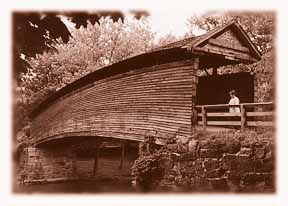Covered Bridges in Virginia
 In memory or imagination, covered bridges conjure up sights and sounds of days gone by. In Virginia, they began to dot the countryside nearly two centuries ago. Spanning rivers and streams, their number grew to the hundreds.
In memory or imagination, covered bridges conjure up sights and sounds of days gone by. In Virginia, they began to dot the countryside nearly two centuries ago. Spanning rivers and streams, their number grew to the hundreds.
Eventually they gave way to their vulnerability to flood and fire, and to the technology that replaced the wooden peg with the metal bolt and the broadtimbers with narrow steel. By 1900, the overhead steel truss bridge had become the engineers' design of choice.
Relatively few covered bridges survived into the early years of the 20th century. Most of them reflected the evolution in design of three pioneers in the annals of bridge construction:
- Theodore Burr, who patented the Burr arch bridge in 1817
- Ithiel Town, who patented the Town lattice design in 1835
- William Howe, who in 1840 patented a design that combined iron uprights with wooden supports
Today in Virginia, only seven covered bridges still stand. Four have been preserved as landmarks and three are on private property. You are invited to visit these picturesque structures that span time as well as water.
We also invite you to view our video Covered Bridges In Virginia
Virginia's Covered Bridges

Meem's Bottom Bridge (1894), North Fork of the Shenandoah River in Shenandoah County.

Bob White Bridge (1921), Smith River in Patrick County (washed away Sept. 29, 2015)

Jack's Creek Bridge (1914), Smith River in Patrick County

Humpback Bridge (1857), Dunlap Creek in Alleghany County

Sinking Creek Bridge (circa 1916), Sinking Creek in Giles County
Three bridges are on private property:
- C.K. Reynolds Covered Bridge, Giles County
(Owner intends to rebuild after storm destroyed bridge in March 2017.) - Biedler Farm Bridge, Rockingham County.
- Links Farm Bridge, Giles County.



